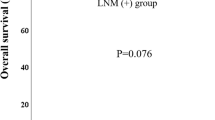Summary.
Background: Current problems in gastric cancer surgery concern the extent of gastric resection, the need for abdominal evisceration, the degree of lymphadenectomy, and optimal preoperative tumor staging procedure. Patients and methods: In a restrospective analysis, data on epidemiology, extent of surgery, histopathology, postoperative complications, mortality, and survival in 284 gastric cancer patients were evaluated. Results: Our results are in favor of subtotal gastrectomy performed for all T stages located in the distal or middle third, provided that a tumor-free margin of 5 cm in intestinal type and 10 cm in diffuse Lauren's type tumor can be achieved. Additional organ resections are indicated only if direct tumor invasion has occurred, and should not be part of an extended lymphadenectomy procedure. The degree of lymph node removal should be guided by the primary tumor site. Multimodal therapeutic approaches and high postoperative mortality after exploratory laparotomy justify the use of diagnostic laparoscopy in T3/4 tumors and if diagnostic scans suggest possible tumor spread. Conclusion: Even though surgery for gastric cancer is well standardized, a tailored surgical approach to different extent of gastric cancer appears warranted.
Zusammenfassung.
Hintergrund: Aktuelle Aspekte der Magencarcinomchirurgie betreffen das Resektionsausmaß am Magen, die Indikation zur multivisceralen Resektion, den Umfang der Lymphknotendissektion und ein optimales präoperatives Tumorstaging. Patienten und Methodik: In einer retrospektiven Analyse wurden epidemiologische, operative, postoperative und histopathologische Daten bei 284 Magencarcinompatienten erfaßt. Ergebnisse: Unsere Ergebnisse favorisieren die subtotale Gastrektomie bei allen T-Stadien im distalen und mittleren Magendrittel unter der Voraussetzung eines oralen Sicherheitsabstands von 5 cm beim intestinalen und von 10 cm beim diffusen Lauren-Typ. Zusätzliche Organresektionen sind nur bei direkter Tumorinvasion und nicht im Rahmen einer D2-Lymphknotendissektion indiziert. Der Umfang der D2-Lymphknotendissektion sollte sich an der Lokalisation des Primärtumors orientieren. Multimodale Therapiekonzepte und die hohe Letalität der explorativen Laparotomie begründen den Einsatz der diagnostischen Laparoskopie bei T3/4-Tumoren und bei Verdacht auf Fernmetastasierung in der bildgebenden Diagnostik. Schlußfolgerung: Trotz standardisierter Magencarcinomchirurgie scheint ein an Lokalisation und Ausdehnung des Tumors orientiertes chirurgisches Konzept gerechtfertigt.
Similar content being viewed by others
Author information
Authors and Affiliations
Rights and permissions
About this article
Cite this article
Schumacher, I., Hunsicker, A., Petermann, J. et al. Magencarcinomchirurgie – Bewährtes und Kontroverses Retrospektive 10-Jahres-Analyse mit Diskussion aktueller Aspekte. Chirurg 70, 1447–1453 (1999). https://doi.org/10.1007/s001040050085
Published:
Issue Date:
DOI: https://doi.org/10.1007/s001040050085




